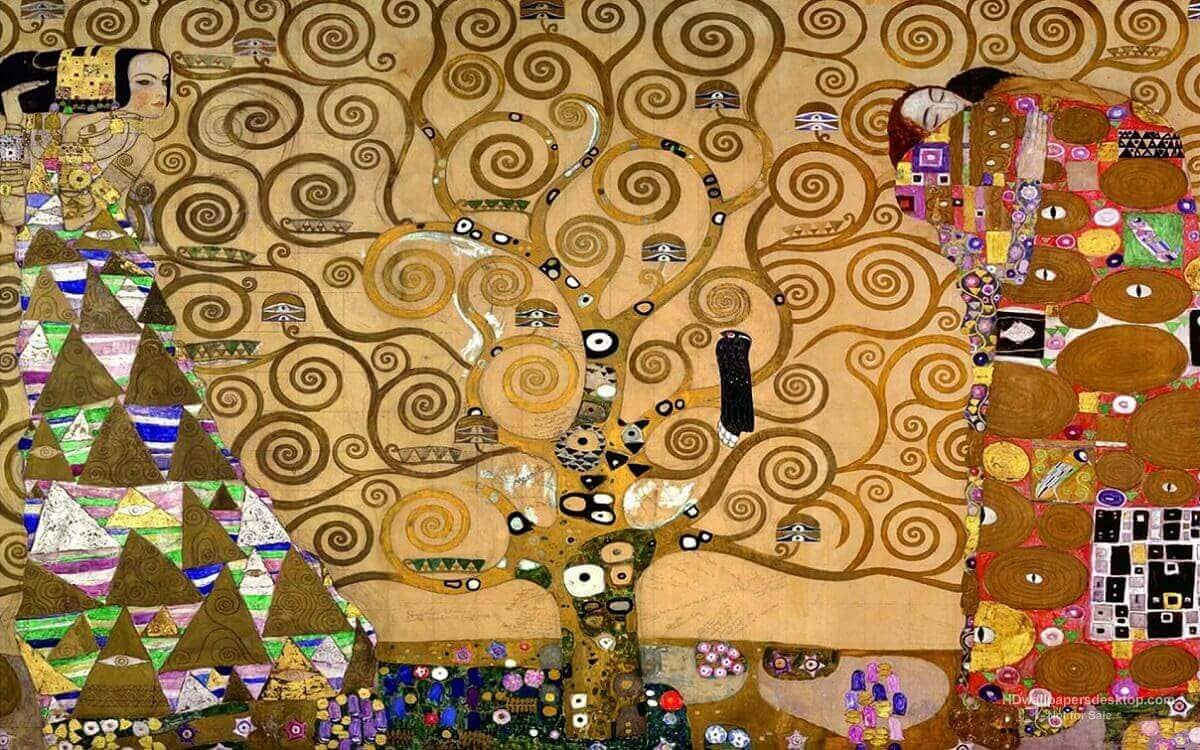
What Is the Meaning of The Tree of Life by Klimt
Gustav Klimt, one of the most celebrated artists of the late 19th and early 20th centuries, is renowned for his unique style that blends symbolism, decorative patterns, and gold leaf into mesmerizing compositions. Among his many masterpieces, The Tree of Life stands out as one of the most iconic and enigmatic paintings. This extraordinary piece of art is much more than just a visual delight; it is a profound representation of life, interconnectedness, and spirituality. But what exactly does Klimt’s Tree of Life mean? Why is it so significant, and where can one find this masterpiece today? Let’s explore the depths of this renowned painting.
At first glance, The Tree of Life appears as an intricate, almost hypnotic composition of swirling branches, golden hues, and stylized human figures. However, beneath this decorative exterior lies a deep, symbolic meaning.
Klimt’s Tree of Life is an embodiment of the eternal cycle of life. The tree itself serves as a universal symbol, representing growth, wisdom, and the connection between heaven, earth, and the underworld. The swirling branches reach toward the sky, symbolizing aspirations and the expansion of knowledge. The sturdy trunk represents the foundation of life, while the roots delve deep into the earth, signifying our connection to the past and our ancestry.
Moreover, the painting’s golden background enhances its spiritual and mystical quality. Gold, often associated with divinity and eternity, imbues the tree with a sense of immortality and divine energy. This choice of color and material aligns with Klimt’s signature style, which was heavily influenced by Byzantine mosaics and sacred art.
What Is the Significance of The Tree of Life Painting by Klimt?
Klimt’s Tree of Life is significant for multiple reasons, both artistically and philosophically.
1. A Masterpiece of the Vienna Secession Movement
Klimt was a leading figure in the Vienna Secession, an art movement that broke away from traditional academic art and embraced modernist experimentation. His work, including The Tree of Life, reflects the movement’s ideals, incorporating ornamental patterns, symbolism, and innovative techniques. The painting epitomizes the Secessionist belief in the unity of art and design, blending decorative elements with profound meaning.
2. A Symbol of Unity and Interconnection
One of the most striking aspects of The Tree of Life is its interconnected branches, which seem to weave an intricate web across the canvas. This imagery represents the interconnectedness of all living beings, suggesting that life is a complex, interwoven journey. The painting invites viewers to contemplate the relationships between different forces, life and death, light and darkness, growth and decay.
3. Philosophical and Spiritual Interpretations
Many scholars and art enthusiasts interpret The Tree of Life through a spiritual lens. The tree has been a potent symbol in various religious and mythological traditions, from the Norse Yggdrasil to the biblical Tree of Knowledge. Klimt’s depiction resonates with these ancient beliefs, serving as a reminder of the cyclical nature of existence and the pursuit of enlightenment.
Additionally, some interpretations suggest that the painting represents the concept of eternal love and harmony. The presence of human figures in The Tree of Life, notably the embracing couple in the panel The Fulfillment, reinforces the idea of love as an essential part of the human experience.
Why Is The Tree of Life Famous?
The Tree of Life remains one of Klimt’s most famous works for several reasons:
1. Its Unique Aesthetic and Style
The painting is an extraordinary example of Klimt’s signature “Golden Phase,” characterized by the lavish use of gold leaf and intricate patterns. This opulent, dreamlike quality makes The Tree of Life instantly recognizable and captivating to art lovers worldwide.
2. Its Deep Symbolism
Unlike many artworks that derive their fame from sheer technical skill, The Tree of Life captivates viewers through its profound symbolism. The painting invites endless interpretations, allowing individuals from different cultures and backgrounds to find personal meaning within its swirling branches.
3. Its Influence on Art and Popular Culture
Over the years, The Tree of Life has inspired countless artists, designers, and philosophers. Its motifs have been adapted into various forms of art, including textiles, jewelry, and contemporary digital designs. The painting’s imagery continues to be referenced in discussions about spirituality, psychology, and the human experience.
4. Its Association with Klimt’s Legacy
As one of Klimt’s most famous works, The Tree of Life cements his place in the history of art. It showcases his mastery of symbolism and decorative composition, making it a highlight of his illustrious career.
What Does The Tree of Life Symbolize?
The tree of life is an ancient and universal symbol that has appeared in numerous cultures and religious traditions. Klimt’s interpretation embodies several key themes:
1. Connection Between Heaven, Earth, and the Underworld
Much like the mythological Tree of Life in various traditions, Klimt’s version represents the link between different realms of existence. The roots delve into the earth, the trunk stands firmly in the present world, and the branches stretch toward the heavens, illustrating the unity of all planes of existence.
2. The Cycle of Life and Death
The swirling branches suggest movement and change, reinforcing the idea that life is in constant motion. The tree’s form reflects the cyclical nature of life, from birth and growth to decay and rebirth.
3. Growth and Knowledge
Trees have long been associated with wisdom and learning, as seen in mythologies where sacred trees grant knowledge or enlightenment. In Klimt’s painting, the intricate, twisting branches suggest the complexity of human thought and the never-ending pursuit of understanding.
4. Love and Unity
The presence of human figures, particularly the embracing lovers, signifies love as an essential force of life. The intertwining branches may also symbolize the interconnected nature of relationships and the bonds that hold people together.
Where Is Gustav Klimt’s Tree of Life?
Unlike many of Klimt’s famous standalone paintings, The Tree of Life is part of a larger decorative work. The painting is a segment of a three-panel mural created for the Stoclet Palace in Brussels, Belgium. Commissioned by the wealthy industrialist Adolphe Stoclet in 1905, the mural was designed as part of an opulent Art Nouveau interior.
The Stoclet Palace itself is a UNESCO World Heritage site, known for its architectural and artistic significance. However, because it remains privately owned, The Tree of Life is not on public display. Despite this, high-quality reproductions and digital interpretations allow art enthusiasts to appreciate its beauty and meaning worldwide.
Gustav Klimt’s The Tree of Life is more than just a visually stunning painting, it is a profound exploration of existence, spirituality, and human connection. Its intricate patterns, golden hues, and deep symbolism continue to captivate audiences, making it one of the most cherished works in art history. Although the original resides in a private setting, its impact extends far beyond the walls of the Stoclet Palace, inspiring generations to reflect on the beauty and complexity of life itself.




